

Agimat. An agimat, intended to be worn with a necklace.

Agimat or bertud or anting-anting, is a Filipino word for "amulet" or "charm".[1] Anting-anting is also a Filipino system of magic and sorcery with special use of the above mentioned talismans, amulets, and charms. It is part of a wider South-East Asian tradition of tribal jewelry, as "gantung" (meaning "hanging") in Indonesian/Malay and "anting-anting" (meaning "ear pendant") in Javanese . Types of Agimat[edit] In the Philippine occult tradition, there is usually a corresponding agimat to deal with in a particular area in a person's life. Baetylus. The Emesa temple to the sun god El-Gabal, with the Baetylus "holy stone" Baetylus (also Bethel, or Betyl) is a word denoting a sacred stone, which was supposedly endowed with life.
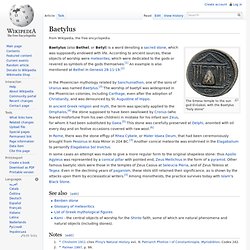
According to ancient sources, these objects of worship were meteorites, which were dedicated to the gods or revered as symbols of the gods themselves.[1] An example is also mentioned at Bethel in Genesis 28:11-19. In Rome, there was the stone effigy of Rhea Cybele, or Mater Idaea Deum, that had been ceremoniously brought from Pessinus in Asia Minor in 204 BC.[3] Another conical meteorite was enshrined in the Elagabalium to personify Elagabalus Sol Invictus. See also[edit] Cintamani. Cintāmaṇi (Sanskrit; Devanagari: चिन्तामणि) also spelled as Chintamani (or the Chintamani Stone) is a wish-fulfilling jewel within both Hindu and Buddhist traditions, equivalent to the philosopher's stone (Paras Pathar) in Western alchemy.[1] In Buddhism it is held by the bodhisattvas, Avalokiteshvara and Ksitigarbha.
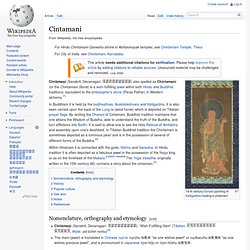
It is also seen carried upon the back of the Lung ta (wind horse) which is depicted on Tibetan prayer flags. By reciting the Dharani of Cintamani, Buddhist tradition maintains that one attains the Wisdom of Buddha, able to understand the truth of the Buddha, and turn afflictions into Bodhi. It is said to allow one to see the Holy Retinue of Amitabha and assembly upon one's deathbed. Imperial Regalia of Japan. Artist's impression of the Imperial Regalia of Japan.
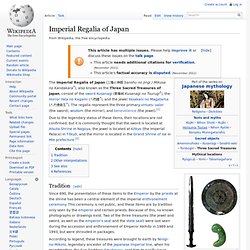
The Imperial Regalia of Japan (三種の神器, Sanshu no Jingi / Mikusa no Kandakara?) , also known as the Three Sacred Treasures of Japan, consist of the sword Kusanagi (草薙劍, Kusanagi no Tsurugi?) , the mirror Yata no Kagami (八咫鏡?) Four Treasures of the Tuatha Dé Danann. Golden Fleece. Plot[edit] Ino was jealous of her stepchildren and plotted their deaths: in some versions, she persuaded Athamas that sacrificing Phrixus was the only way to end the drought.

Nephele, or her spirit, appeared to the children with a winged ram whose fleece was of gold.[4] The ram had been sired by Poseidon in his primitive ram-form upon Theophane, a nymph[5] and the granddaughter of Helios, the sun-god. According to Hyginus,[6] Poseidon carried Theophane to an island where he made her into an ewe, so that he could procreate with her among the flocks. There Theophane's other suitors could not distinguish the ram-god and his consort.[7] Holy Grail. How at the Castle of Corbin a Maiden Bare in the Sangreal and Foretold the Achievements of Galahad: illustration by Arthur Rackham, 1917 The Holy Grail is a dish, plate, stone, or cup that is part of an important theme of Arthurian literature.

A grail, wondrous but not explicitly holy, first appears in Perceval le Gallois, an unfinished romance by Chrétien de Troyes:[1] it is a processional salver used to serve at a feast. Chrétien's story attracted many continuators, translators and interpreters in the later 12th and early 13th centuries, including Wolfram von Eschenbach, who makes the grail a great precious stone that fell from the sky. Origins[edit] The Grail was considered a bowl or dish when first described by Chrétien de Troyes. Impact on the poorest. Karun Treasure. Jug from Lydian Treasure found near Uşak.

Kaustubha. Pandora's box. Pandora opens the pithos given to her by Zeus, thus releasing all the bad things of the world.
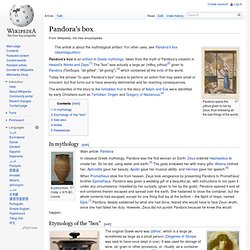
Today the phrase "to open Pandora's box" means to perform an action that may seem small or innocent, but that turns out to have severely detrimental and far-reaching consequences. The similarities of the story to the forbidden fruit in the story of Adam and Eve were identified by early Christians such as Tertullian, Origen and Gregory of Nazianzus.[4] In mythology[edit] A pithos from Crete, c. 675 BC.
Louvre In classical Greek mythology, Pandora was the first woman on Earth. Relics associated with Jesus. A number of relics associated with Jesus have been claimed and displayed throughout the history of Christianity.
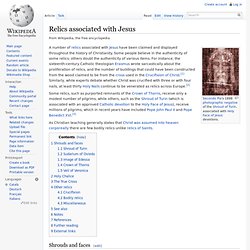
Sessho-seki. The Sessho-seki (Japanese: 殺生石), or "Killing Stone," is an object in Japanese mythology.

It is said that the stone kills anyone who comes into contact with it. The stone is believed to be the transformed corpse of Tamamo no Mae, a beautiful woman who was exposed to be a kind nine-tailed fox working for an evil daimyo plotting to kill the Japanese Emperor Konoe and take his throne. Stone of Giramphiel. Thirteen Treasures of the Island of Britain.
The Thirteen Treasures of the Island of Britain (Welsh: Tri Thlws ar Ddeg Ynys Prydain) are a series of items in late medieval Welsh tradition. Lists of the items appear in texts dating to the 15th and 16th centuries.[2] Most of the items are placed in the Hen Ogledd or "Old North", the Brittonic-speaking parts of what is now southern Scotland and Northern England; some early manuscripts refer to the whole list specifically as treasures "that were in the North".[2] The number of treasures is always given as thirteen, but some later versions list different items, replacing or combining entries to maintain the number.[2] Later versions also supplement the plain list with explanatory comments about each treasure. List[edit] 1. White-Hilt, the Sword of Rhydderch Hael (Dyrnwyn, gleddyf Rhydderch Hael): "if a well-born man drew it himself, it burst into flame from its hilt to its tip. 2. 3. 4. 5. 6. 7. 8. 9. 10-11. 12. 14/15.
Description[edit] Yata no Kagami. Artist's impression of the Imperial Regalia of Japan Yata no Kagami (八咫鏡?) Is a sacred mirror that is part of the Imperial Regalia of Japan. It is said to be housed in Ise Grand Shrine in Mie Prefecture, Japan, although a lack of public access makes this difficult to verify.